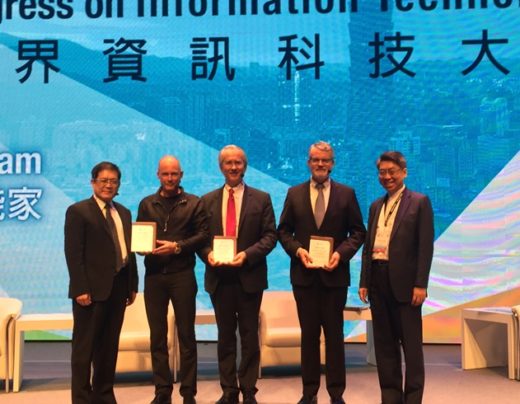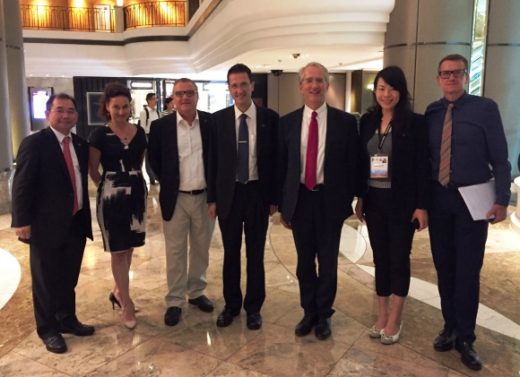2017 Word Information Technology Forum (WCIT) Report

WCIT circular economy forum
Monday, 11 September 2017
The ECCT's Low Carbon Initiative (LCI) was a co-organiser of the "Smart Growth Towards a Circular Economy Forum". The forum was one of the series of events that were part of the World Congress on Information Technology (WCIT), hosted this year in Taipei. The WCIT is a flagship event which has been organized by the World Information Technology and Services Alliance (WITSA) since 1978, and is often referred to as the "Olympics" of the ICT industry.

The speakers at the forum were Patrick Thomas, CEO of Covestro; Bertrand Piccard, Chairman of the Solar Impulse Foundation and Yang Wei-fuu, Vice Minister of the Ministry of Economic Affairs (MOEA). The forum was moderated by Martin Eberts, Director-General, German Institute Taipei. Each of the speakers gave a short presentation, after which they took part in a lively panel discussion exchange of ideas on circular economy concepts. In his speech Patrick Thomas gave his views on the circular economy and the impacts on sustainable growth. He said that the linear economic model that was accelerated by the industrial revolution remains predominant today and is having a negative impact on the environment and people.
He noted that not only is the economic model linear but people also tend to think linearly. What we need is a shift in mindset, in particular how we look at waste. According to Thomas, there is no such thing as waste, just a misused resource. Instead of viewing waste as a by-product to be discarded, we should view it as an input in a circular production process. In addition to a shift in mindset, we also need breakthrough technology that can be employed profitably to lower carbon input, close the carbon cycle and add value. While companies have been preoccupied with finding ways to increase capital employed, they should now also focus on return on carbon employed.
As part of its so-called "Dream Production" project, Covestro has developed and started producing a material, branded as Cardyon, which uses CO2 as a raw material. Cardyon polyol can be used to make products such as foam matrasses and car seats. The new material contains about 20% carbon, which has replaced the traditional petroleum-based raw material. Tests have also shown that the foam is flexible and possesses the same qualities and capabilities as conventional products. Besides being environmentally-friendlier than its predecessors, the product is also cheaper to produce, which translates into higher profits.
In the next speech, Swiss psychiatrist and balloonist Bertrand Piccard introduced Solar Impulse, the long-range experimental solar-powered aircraft, in which he, together with Swiss engineer and businessman André Borschberg, succeeded in circumnavigating the earth.
According to Piccard, when he first proposed the idea of using only solar energy to fly a plane around the earth, all experts told him it was impossible. This, he said, was because they were stuck in the paradigm or conventional mindset at the time which held that it was not possible to produce enough energy from solar panels to fly a plane, both while the sun is shining and at night, using batteries that had been charged by solar panels during the day. However, he and Borschberg proved the naysayers wrong.
"When you are stuck in a paradigm, then you have to change the paradigm," said Piccard. That is exactly what they did. They achieved their remarkable feat by designing the lightest and most energy-efficient plane possible, by drawing on experts in chemistry and materials. (Covestro was one of the material suppliers). According to Piccard, the Solar Impulse was 10 times lighter than any glider built previously.
The second version of Solar Impulse (Solar Impulse 2) completed the world's first circumnavigation of the Earth (a journey of around 42,000) by a piloted fixed-wing aircraft using only solar power in July 2016.
Now that the Solar Impulse has achieved what was previously thought to be an impossible feat, Piccard has moved onto the next phase of his vision for a better world.
If an airplane can fly around the world without a drop fuel, he believes that clean technologies can undoubtedly be implemented on the ground to make a cleaner, more efficient and richer world. In particular, the record-breaking solo flight of five days and five nights without fuel from Nagoya to Hawaii, shows what is possible. Piccard's mission now is to promote the message that we are capable of a cleaner and greener future just using technology that is already available.
According to Piccard, many of the solutions we use today from engines, to lighting to electricity generation and distribution to building designs, are outdated. As the Solar Impulse showed, there is too much focus on generating energy when we could radically reduce the amount of energy we use just by employing existing technology.
Closing the carbon loop is not only good for the planet but it could also drive new business models that could stimulate economic growth.
In November 2016, Piccard launched the World Alliance for Efficient Solutions. This is the second phase in the realization of his vision that clean technologies can accomplish impossible goals and offer tangible solutions to solve many of the challenges facing global society today.
The goal of the Solar Impulse Foundation and the World Alliance for Efficient Solutions is to demonstrate which solutions are available to deliver on environmental and health targets.
The alliance is committed to advancing efficient solutions worldwide as a way to set the world on a path toward sustainable development and to improve the quality of life on earth.
The alliance brings together start-ups, companies, institutions and organisations producing, implementing or supporting the use of efficient solutions with the goal of creating synergies and sharing knowledge to improve the overall value chain. The alliance demonstrates concrete, tangible and efficient solutions to support governments, corporations and institutions in reaching their environmental and health targets, with respect to their specific situation.
The alliance is currently calling for proposals and solutions from companies and organisations that will help to realise the goals. It aims to find 1,000 efficient and viable solutions that could help governments, municipalities and corporations reach their environmental and health targets. In this regard, Piccard welcomed submissions from Taiwan.In his speech, MOEA Vice Minister Yang Wei-fuu outlined some of the policies already implemented and those being planned by the MOEA to encourage the development of a circular economy in Taiwan.
In the Q&A session that followed the presentations, speakers made the point that the automotive industry had done more to make their production cycles circular than the IT industry, showing that the IT industry had more work to do.
On the subject of energy usage, Piccard pointed out that we could cut energy usage dramatically just by using smart grids and balancing energy usage over the course of the day.
On a question as to where one should start to make a meaningful impact towards creating a better environment, Thomas said that an immediate ban on plastic in landfills would be an important first step. Since plastic can be re-used it is senseless to bury it or allow it to further pollute the world's rivers and oceans. Besides the environmental benefits, as countries such as Germany and Taiwan have shown, recycling can be a profitable business.
On a question as to how to speed up the drive towards a circular economy, Piccard likened the back and forth between governments and the private sector to a game of ping pong, whereby each try to shift responsibility to the other for taking action. But according to Piccard, they are both right. Both a legal framework and corporate action are needed. It is the responsibility of governments to set the right policies and ambitious environmental targets while it is also the responsibility of companies to take action to create and provide the right solutions and make their business models more circular.
He added that politicians need to be real leaders, not just administrators, while companies need to make greater efforts to find better solutions.
The legal framework needs to stimulate the shift towards energy efficiency in electricity generation and distribution, building designs and insulation. There are already solutions, for example for energy neutral buildings that could be employed.Thomas said that his company is working on energy storage solutions, which will be needed on a large scale as electricity grids shift to an increasing reliance on renewables.Piccard also made the point that what is often missed in arguments is the hidden gains of green technologies to public health. With so many health issues caused by pollution such as lung cancer, bronchitis and asthma, employing green solutions has the potential to dramatically reduce spending on healthcare.
